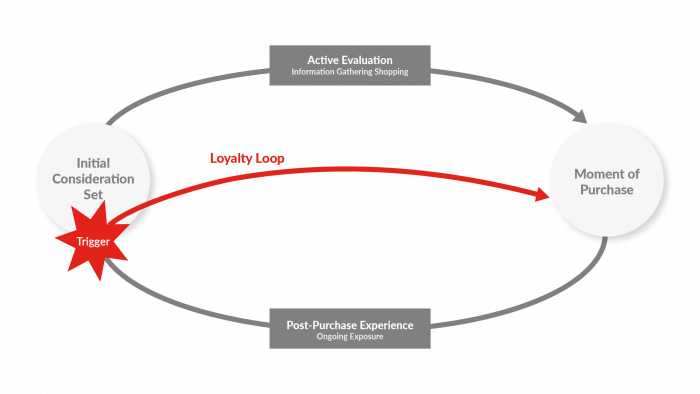Have you heard of the McKinsey Loyalty Loop? It illustrates how customers go through the process of buying things from the company’s perspective. The process is one you’re likely familiar with: it starts with consideration, followed by active evaluation of products and options, and then the purchase. This begins the post-purchase and product experience, which lasts until the next purchase decision—hopefully to buy again from the same company, thus creating a loyalty loop.

From the customer’s perspective, though, the loyalty loop actually looks different, thanks in part to how long customers spend in each of these stages.
Let me explain.
The post-purchase stage can be a long one
Post-purchase and product experiences can last a really long time. From the customer’s perspective, a lasting post-purchase experience changes the Loyalty Loop to look something like this:

Notice how the post-purchase experience expands, gets longer. Also, see how these journeys are the last and most recent experiences a customer will have with a brand before they begin another purchase cycle. Unfortunately, the support journeys that occur during the post-purchase stage don’t always encourage renewing, or purchasing again. And this needs to change: companies need to prioritize resources and initiatives to re-orchestrate these journeys or risk losing customers and degrading customer loyalty overall.
Simply stated, customers want to be able to find or buy anything in three clicks or less. It’s no wonder customers are now making purchase decisions based on their post-purchase support experiences. With this in mind, why aren’t companies prioritizing these experiences?
Elevating post-purchase support through easy customer self-service
Most people begin their search for information with a Google search. And brands spend considerable resources trying to rank content in what has become a highly competitive landscape: the search engine results page (SERP). But very few brands optimized their support content for Google. Many don’t make this content public at all.
Others aren’t putting out timely, authoritative content, such as branded support videos. Instead, customers are seeing content from competitors or third-party sources. All of these search experiences are outside the brand’s control, thus they lack visibility and analytics into these customers journeys.
This makes a rather strong case for letting Google find your post-purchase support content.
Remove friction once they’re on your site
After the customer has several of these false-positive results and failed experiences, they may go directly to the brand’s website. Here, they might find basic FAQs or a section to download PDF manuals, but all they really want is the answer to their question! Unfortunately, PDFs are not easily searchable and if the customer is on their mobile phone, they are stuck pinching and zooming while their frustration increases.
If they know what the problem is, they may type words, phrases, or questions into the onsite search box. However, most content management systems aren’t designed for support, so customers might be lead to a marketing product detail page, causing even more frustration. Thus, while the customers are trying to self-serve, the experience they typically run into ends up being high-friction, low-value.
Closing the loop and keeping customers coming back
For at least the past ten years, there’s been a hyper focus on improving customer experiences. Today, companies can differentiate themselves through these experiences, including post-purchase support journeys. I think back to the recent T-Mobile campaign featuring Rainn Wilson, in which the carrier tells their customers they would not get the standard, awful IVR experience anymore, but a live agent when they need it.
The challenge companies face to improve their experiences is an internal one. It requires a company to take a customer-centric approach that is top down and bottom up, focused on delivering great CX across every journey. Now more than ever, having successful post-purchase experiences is not only vital to building loyalty but essential to putting customers back on the pathway to re-purchasing, renewing, and referring your name along.
This post originally appeared on customerthink.com. Photo by Nathan Dumlao on Unsplash.













1 comment